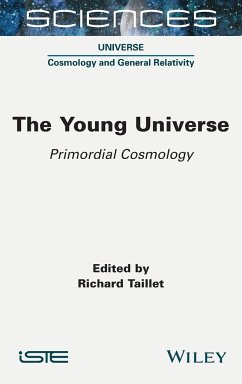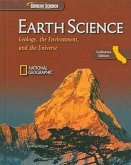The Young Universe
Primordial Cosmology
Herausgeber: Taillet, Richard
The Young Universe
Primordial Cosmology
Herausgeber: Taillet, Richard
- Gebundenes Buch
- Merkliste
- Auf die Merkliste
- Bewerten Bewerten
- Teilen
- Produkt teilen
- Produkterinnerung
- Produkterinnerung
The Young Universe presents four major physical and astrophysical themes related to these extreme phases of the primordial universe. In particular, it presents the physics of the primordial plasma and the concepts of quantum and particle physics necessary to describe this extreme state. It discusses the cosmological background radiation and explores inflation, an extremely rapid expansion phase that is believed to have occurred very early in cosmological history and to have shaped our present universe. The book also provides a synthesis of the dark matter problem.
Andere Kunden interessierten sich auch für
![An Old World, as Seen Through Young Eyes, or, Travels Around the World [microform] An Old World, as Seen Through Young Eyes, or, Travels Around the World [microform]]() An Old World, as Seen Through Young Eyes, or, Travels Around the World [microform]41,99 €
An Old World, as Seen Through Young Eyes, or, Travels Around the World [microform]41,99 €![Earth Science, California Edition: Geology, the Environment, and the Universe Earth Science, California Edition: Geology, the Environment, and the Universe]() Earth Science, California Edition: Geology, the Environment, and the Universe179,99 €
Earth Science, California Edition: Geology, the Environment, and the Universe179,99 €![Nurturing Nature and the Environment with Young Children Nurturing Nature and the Environment with Young Children]() Nurturing Nature and the Environment with Young Children204,99 €
Nurturing Nature and the Environment with Young Children204,99 €![Children, Young People and Care Children, Young People and Care]() Children, Young People and Care206,99 €
Children, Young People and Care206,99 €![Young Entrepreneurs in Sub-Saharan Africa Young Entrepreneurs in Sub-Saharan Africa]() Young Entrepreneurs in Sub-Saharan Africa229,99 €
Young Entrepreneurs in Sub-Saharan Africa229,99 €![The Voice of Unemployed Young Graduates in Wolaita Sodo, Ethiopia The Voice of Unemployed Young Graduates in Wolaita Sodo, Ethiopia]() Belete ShankaThe Voice of Unemployed Young Graduates in Wolaita Sodo, Ethiopia36,99 €
Belete ShankaThe Voice of Unemployed Young Graduates in Wolaita Sodo, Ethiopia36,99 €![Young People, Wellbeing and Sustainable Arctic Communities Young People, Wellbeing and Sustainable Arctic Communities]() Young People, Wellbeing and Sustainable Arctic Communities205,99 €
Young People, Wellbeing and Sustainable Arctic Communities205,99 €-
-
-
The Young Universe presents four major physical and astrophysical themes related to these extreme phases of the primordial universe. In particular, it presents the physics of the primordial plasma and the concepts of quantum and particle physics necessary to describe this extreme state. It discusses the cosmological background radiation and explores inflation, an extremely rapid expansion phase that is believed to have occurred very early in cosmological history and to have shaped our present universe. The book also provides a synthesis of the dark matter problem.
Hinweis: Dieser Artikel kann nur an eine deutsche Lieferadresse ausgeliefert werden.
Hinweis: Dieser Artikel kann nur an eine deutsche Lieferadresse ausgeliefert werden.
Produktdetails
- Produktdetails
- Verlag: Wiley
- Seitenzahl: 352
- Erscheinungstermin: 11. Oktober 2022
- Englisch
- Abmessung: 240mm x 161mm x 23mm
- Gewicht: 692g
- ISBN-13: 9781789450323
- ISBN-10: 1789450322
- Artikelnr.: 64947305
- Herstellerkennzeichnung
- Produktsicherheitsverantwortliche/r
- Europaallee 1
- 36244 Bad Hersfeld
- gpsr@libri.de
- Verlag: Wiley
- Seitenzahl: 352
- Erscheinungstermin: 11. Oktober 2022
- Englisch
- Abmessung: 240mm x 161mm x 23mm
- Gewicht: 692g
- ISBN-13: 9781789450323
- ISBN-10: 1789450322
- Artikelnr.: 64947305
- Herstellerkennzeichnung
- Produktsicherheitsverantwortliche/r
- Europaallee 1
- 36244 Bad Hersfeld
- gpsr@libri.de
Richard Taillet is an astrophysicist at the LAPTh in Annecy, France and Professor at the Université Savoie Mont Blanc, Chambéry, France.
Chapter 1 A Thermal History of the Universe and Primordial Nucleosynthesis
1
Pierre SALATI
1.1 A quick overview 2
1.1.1 A useful refresher of the Friedmann-Lemaître model 2
1.1.2 The major events of the Big Bang 5
1.2 Gamow's ylem 10
1.2.1 Introductory remarks 10
1.2.2 Numerical density 14
1.2.3 Energy density and pressure 16
1.2.4 Entropy density 17
1.2.5 Effective degrees of freedom of the ylem 19
1.2.6 Numerical developments 20
1.3 Cooling kinetics 22
1.3.1 Planck mass 22
1.3.2 Relation between scale factor and temperature 24
1.3.3 Relation between cosmic time and temperature 25
1.4 Thermal decoupling of neutrinos 29
1.4.1 The concept of cross-section 29
1.4.2 Thermal equilibrium breaking 33
1.4.3 The neutrinic fossil radiation 36
1.4.4 The Cowsik and McClelland limit 38
1.5 Primordial nucleosynthesis 41
1.5.1 Transmutation between protons and neutrons 42
1.5.2 Breaking of the neutron-proton equilibrium 46
1.5.3 The formation of deuterium 51
1.5.4 The cooking of light elements 54
1.6 Chemical decoupling of heavy particles 60
1.6.1 Evolutionary equation 62
1.6.2 Approximate solution 63
1.6.3 Relic density 67
1.6.4 The Lee and Weinberg limit 69
1.7 Dissipation of the primordial fog 71
1.7.1 Saha's equilibrium 72
1.7.2 Photoionization and recombination of neutral hydrogen 75
1.7.3 Lyman-alpha line and atomic resonance 78
1.7.4 The three-level atom model 82
1.7.5 Recombination of the primordial plasma and residual ionization 85
1.8 References 89
Chapter 2 Cosmological Microwave Background 93
Julien LESGOURGUES
2.1 Introduction 93
2.1.1 Last scattering surface 93
2.1.2 CMB anisotropies 94
2.1.3 Conventions 96
2.2 Revisiting the Thomson scattering 96
2.2.1 Scattering rate 96
2.2.2 Optical depth 97
2.2.3 Visibility function 98
2.2.4 Diffusion length 99
2.3 Linear cosmological perturbations 100
2.3.1 Why linear perturbations? 100
2.3.2 Classification of perturbations 100
2.3.3 Comoving Fourier space 103
2.3.4 Linearized Einstein equation 105
2.3.5 Species present in the standard cosmological model 106
2.3.6 General equations of motion 107
2.4 Formal description of temperature anisotropies 108
2.4.1 Photon propagation 108
2.4.2 Temperature anisotropy in a given direction 113
2.5 Stochastic theory of cosmological perturbations 117
2.5.1 Initial conditions 118
2.5.2 Power spectrum and transfer functions 123
2.5.3 Spectrum of temperature anisotropies 127
2.6 Physics of temperature anisotropies 131
2.6.1 Line-of-sight integral in Fourier space 131
2.6.2 Perturbation evolution 137
2.6.3 Contributions to the temperature spectrum 142
2.6.4 Dependency on cosmological parameters 150
2.7 Other contributions and observables 156
2.7.1 Overview of CMB polarization 156
2.7.2 CMB gravitational lensing 159
2.7.3 Overview of the role of gravitational waves 160
2.7.4 Astrophysical foreground 161
2.7.5 Spectral distortions 162
2.8 CBM observations 162
2.8.1 Current observations 162
2.8.2 Future observations 169
2.9 References 170
Chapter 3 Cosmological Inflation 173
Sébastien RENAUX-PETEL
3.1 Overview 173
3.2 Introduction 175
3.2.1 Shortcomings of the Hot Big Bang model 175
3.2.2 The mechanism of inflation 179
3.3 Single-field slow-roll inflation 184
3.3.1 Homogeneous dynamics 184
3.3.2 Dynamics of fluctuations 189
3.4 The physics of inflation beyond toy models 215
3.4.1 Ultraviolet sensitivity 216
3.4.2 Multifield effects 222
3.5 Primordial non-Gaussianities 236
3.5.1 Overview 236
3.5.2 Determining primordial non-Gaussianities 239
3.5.3 Non-Gaussian shapes 243
3.6 Conclusion 253
3.7 References 255
Chapter 4 Dark Matter 259
Richard TAILLET
4.1 Introduction 259
4.1.1 Subject presentation 259
4.1.2 Brief historical overview 260
4.1.3 Current interest in the subject 261
4.1.4 Warning 261
4.1.5 Summary of evidence in favor of dark matter 261
4.2 At the galaxy scale 262
4.2.1 Introduction 262
4.2.2 Spiral galaxy rotation curves 263
4.2.3 Velocity dispersion in elliptical galaxies 266
4.2.4 Application to the gravitational case 269
4.2.5 Dwarf spheroid galaxies 271
4.2.6 Our Galaxy 272
4.2.7 Density profiles 274
4.3 At the galaxy cluster scale 276
4.3.1 Velocity dispersion 276
4.3.2 Hot gas X-ray 276
4.3.3 Gravitational lenses 277
4.3.4 The Sunyaev-Zeldovich effect 278
4.4 Cosmology 279
4.4.1 Geometry of the universe 279
4.4.2 Primordial nucleosynthesis 282
4.4.3 The formation of large structures 282
4.5 The nature of dark matter 291
4.5.1 Baryonic candidates 291
4.5.2 Gravity microlensing 294
4.5.3 Particles 303
4.6 Detection 315
4.6.1 Direct detection 315
4.6.2 Indirect detection 321
4.6.3 Clumps 326
4.7 Modified dynamics and gravity 329
4.7.1 MOND theory 329
4.7.2 The Bullet Cluster 330
4.8 Conclusion 332
4.9 References 332
List of Authors 335
Index 337
1
Pierre SALATI
1.1 A quick overview 2
1.1.1 A useful refresher of the Friedmann-Lemaître model 2
1.1.2 The major events of the Big Bang 5
1.2 Gamow's ylem 10
1.2.1 Introductory remarks 10
1.2.2 Numerical density 14
1.2.3 Energy density and pressure 16
1.2.4 Entropy density 17
1.2.5 Effective degrees of freedom of the ylem 19
1.2.6 Numerical developments 20
1.3 Cooling kinetics 22
1.3.1 Planck mass 22
1.3.2 Relation between scale factor and temperature 24
1.3.3 Relation between cosmic time and temperature 25
1.4 Thermal decoupling of neutrinos 29
1.4.1 The concept of cross-section 29
1.4.2 Thermal equilibrium breaking 33
1.4.3 The neutrinic fossil radiation 36
1.4.4 The Cowsik and McClelland limit 38
1.5 Primordial nucleosynthesis 41
1.5.1 Transmutation between protons and neutrons 42
1.5.2 Breaking of the neutron-proton equilibrium 46
1.5.3 The formation of deuterium 51
1.5.4 The cooking of light elements 54
1.6 Chemical decoupling of heavy particles 60
1.6.1 Evolutionary equation 62
1.6.2 Approximate solution 63
1.6.3 Relic density 67
1.6.4 The Lee and Weinberg limit 69
1.7 Dissipation of the primordial fog 71
1.7.1 Saha's equilibrium 72
1.7.2 Photoionization and recombination of neutral hydrogen 75
1.7.3 Lyman-alpha line and atomic resonance 78
1.7.4 The three-level atom model 82
1.7.5 Recombination of the primordial plasma and residual ionization 85
1.8 References 89
Chapter 2 Cosmological Microwave Background 93
Julien LESGOURGUES
2.1 Introduction 93
2.1.1 Last scattering surface 93
2.1.2 CMB anisotropies 94
2.1.3 Conventions 96
2.2 Revisiting the Thomson scattering 96
2.2.1 Scattering rate 96
2.2.2 Optical depth 97
2.2.3 Visibility function 98
2.2.4 Diffusion length 99
2.3 Linear cosmological perturbations 100
2.3.1 Why linear perturbations? 100
2.3.2 Classification of perturbations 100
2.3.3 Comoving Fourier space 103
2.3.4 Linearized Einstein equation 105
2.3.5 Species present in the standard cosmological model 106
2.3.6 General equations of motion 107
2.4 Formal description of temperature anisotropies 108
2.4.1 Photon propagation 108
2.4.2 Temperature anisotropy in a given direction 113
2.5 Stochastic theory of cosmological perturbations 117
2.5.1 Initial conditions 118
2.5.2 Power spectrum and transfer functions 123
2.5.3 Spectrum of temperature anisotropies 127
2.6 Physics of temperature anisotropies 131
2.6.1 Line-of-sight integral in Fourier space 131
2.6.2 Perturbation evolution 137
2.6.3 Contributions to the temperature spectrum 142
2.6.4 Dependency on cosmological parameters 150
2.7 Other contributions and observables 156
2.7.1 Overview of CMB polarization 156
2.7.2 CMB gravitational lensing 159
2.7.3 Overview of the role of gravitational waves 160
2.7.4 Astrophysical foreground 161
2.7.5 Spectral distortions 162
2.8 CBM observations 162
2.8.1 Current observations 162
2.8.2 Future observations 169
2.9 References 170
Chapter 3 Cosmological Inflation 173
Sébastien RENAUX-PETEL
3.1 Overview 173
3.2 Introduction 175
3.2.1 Shortcomings of the Hot Big Bang model 175
3.2.2 The mechanism of inflation 179
3.3 Single-field slow-roll inflation 184
3.3.1 Homogeneous dynamics 184
3.3.2 Dynamics of fluctuations 189
3.4 The physics of inflation beyond toy models 215
3.4.1 Ultraviolet sensitivity 216
3.4.2 Multifield effects 222
3.5 Primordial non-Gaussianities 236
3.5.1 Overview 236
3.5.2 Determining primordial non-Gaussianities 239
3.5.3 Non-Gaussian shapes 243
3.6 Conclusion 253
3.7 References 255
Chapter 4 Dark Matter 259
Richard TAILLET
4.1 Introduction 259
4.1.1 Subject presentation 259
4.1.2 Brief historical overview 260
4.1.3 Current interest in the subject 261
4.1.4 Warning 261
4.1.5 Summary of evidence in favor of dark matter 261
4.2 At the galaxy scale 262
4.2.1 Introduction 262
4.2.2 Spiral galaxy rotation curves 263
4.2.3 Velocity dispersion in elliptical galaxies 266
4.2.4 Application to the gravitational case 269
4.2.5 Dwarf spheroid galaxies 271
4.2.6 Our Galaxy 272
4.2.7 Density profiles 274
4.3 At the galaxy cluster scale 276
4.3.1 Velocity dispersion 276
4.3.2 Hot gas X-ray 276
4.3.3 Gravitational lenses 277
4.3.4 The Sunyaev-Zeldovich effect 278
4.4 Cosmology 279
4.4.1 Geometry of the universe 279
4.4.2 Primordial nucleosynthesis 282
4.4.3 The formation of large structures 282
4.5 The nature of dark matter 291
4.5.1 Baryonic candidates 291
4.5.2 Gravity microlensing 294
4.5.3 Particles 303
4.6 Detection 315
4.6.1 Direct detection 315
4.6.2 Indirect detection 321
4.6.3 Clumps 326
4.7 Modified dynamics and gravity 329
4.7.1 MOND theory 329
4.7.2 The Bullet Cluster 330
4.8 Conclusion 332
4.9 References 332
List of Authors 335
Index 337
Chapter 1 A Thermal History of the Universe and Primordial Nucleosynthesis
1
Pierre SALATI
1.1 A quick overview 2
1.1.1 A useful refresher of the Friedmann-Lemaître model 2
1.1.2 The major events of the Big Bang 5
1.2 Gamow's ylem 10
1.2.1 Introductory remarks 10
1.2.2 Numerical density 14
1.2.3 Energy density and pressure 16
1.2.4 Entropy density 17
1.2.5 Effective degrees of freedom of the ylem 19
1.2.6 Numerical developments 20
1.3 Cooling kinetics 22
1.3.1 Planck mass 22
1.3.2 Relation between scale factor and temperature 24
1.3.3 Relation between cosmic time and temperature 25
1.4 Thermal decoupling of neutrinos 29
1.4.1 The concept of cross-section 29
1.4.2 Thermal equilibrium breaking 33
1.4.3 The neutrinic fossil radiation 36
1.4.4 The Cowsik and McClelland limit 38
1.5 Primordial nucleosynthesis 41
1.5.1 Transmutation between protons and neutrons 42
1.5.2 Breaking of the neutron-proton equilibrium 46
1.5.3 The formation of deuterium 51
1.5.4 The cooking of light elements 54
1.6 Chemical decoupling of heavy particles 60
1.6.1 Evolutionary equation 62
1.6.2 Approximate solution 63
1.6.3 Relic density 67
1.6.4 The Lee and Weinberg limit 69
1.7 Dissipation of the primordial fog 71
1.7.1 Saha's equilibrium 72
1.7.2 Photoionization and recombination of neutral hydrogen 75
1.7.3 Lyman-alpha line and atomic resonance 78
1.7.4 The three-level atom model 82
1.7.5 Recombination of the primordial plasma and residual ionization 85
1.8 References 89
Chapter 2 Cosmological Microwave Background 93
Julien LESGOURGUES
2.1 Introduction 93
2.1.1 Last scattering surface 93
2.1.2 CMB anisotropies 94
2.1.3 Conventions 96
2.2 Revisiting the Thomson scattering 96
2.2.1 Scattering rate 96
2.2.2 Optical depth 97
2.2.3 Visibility function 98
2.2.4 Diffusion length 99
2.3 Linear cosmological perturbations 100
2.3.1 Why linear perturbations? 100
2.3.2 Classification of perturbations 100
2.3.3 Comoving Fourier space 103
2.3.4 Linearized Einstein equation 105
2.3.5 Species present in the standard cosmological model 106
2.3.6 General equations of motion 107
2.4 Formal description of temperature anisotropies 108
2.4.1 Photon propagation 108
2.4.2 Temperature anisotropy in a given direction 113
2.5 Stochastic theory of cosmological perturbations 117
2.5.1 Initial conditions 118
2.5.2 Power spectrum and transfer functions 123
2.5.3 Spectrum of temperature anisotropies 127
2.6 Physics of temperature anisotropies 131
2.6.1 Line-of-sight integral in Fourier space 131
2.6.2 Perturbation evolution 137
2.6.3 Contributions to the temperature spectrum 142
2.6.4 Dependency on cosmological parameters 150
2.7 Other contributions and observables 156
2.7.1 Overview of CMB polarization 156
2.7.2 CMB gravitational lensing 159
2.7.3 Overview of the role of gravitational waves 160
2.7.4 Astrophysical foreground 161
2.7.5 Spectral distortions 162
2.8 CBM observations 162
2.8.1 Current observations 162
2.8.2 Future observations 169
2.9 References 170
Chapter 3 Cosmological Inflation 173
Sébastien RENAUX-PETEL
3.1 Overview 173
3.2 Introduction 175
3.2.1 Shortcomings of the Hot Big Bang model 175
3.2.2 The mechanism of inflation 179
3.3 Single-field slow-roll inflation 184
3.3.1 Homogeneous dynamics 184
3.3.2 Dynamics of fluctuations 189
3.4 The physics of inflation beyond toy models 215
3.4.1 Ultraviolet sensitivity 216
3.4.2 Multifield effects 222
3.5 Primordial non-Gaussianities 236
3.5.1 Overview 236
3.5.2 Determining primordial non-Gaussianities 239
3.5.3 Non-Gaussian shapes 243
3.6 Conclusion 253
3.7 References 255
Chapter 4 Dark Matter 259
Richard TAILLET
4.1 Introduction 259
4.1.1 Subject presentation 259
4.1.2 Brief historical overview 260
4.1.3 Current interest in the subject 261
4.1.4 Warning 261
4.1.5 Summary of evidence in favor of dark matter 261
4.2 At the galaxy scale 262
4.2.1 Introduction 262
4.2.2 Spiral galaxy rotation curves 263
4.2.3 Velocity dispersion in elliptical galaxies 266
4.2.4 Application to the gravitational case 269
4.2.5 Dwarf spheroid galaxies 271
4.2.6 Our Galaxy 272
4.2.7 Density profiles 274
4.3 At the galaxy cluster scale 276
4.3.1 Velocity dispersion 276
4.3.2 Hot gas X-ray 276
4.3.3 Gravitational lenses 277
4.3.4 The Sunyaev-Zeldovich effect 278
4.4 Cosmology 279
4.4.1 Geometry of the universe 279
4.4.2 Primordial nucleosynthesis 282
4.4.3 The formation of large structures 282
4.5 The nature of dark matter 291
4.5.1 Baryonic candidates 291
4.5.2 Gravity microlensing 294
4.5.3 Particles 303
4.6 Detection 315
4.6.1 Direct detection 315
4.6.2 Indirect detection 321
4.6.3 Clumps 326
4.7 Modified dynamics and gravity 329
4.7.1 MOND theory 329
4.7.2 The Bullet Cluster 330
4.8 Conclusion 332
4.9 References 332
List of Authors 335
Index 337
1
Pierre SALATI
1.1 A quick overview 2
1.1.1 A useful refresher of the Friedmann-Lemaître model 2
1.1.2 The major events of the Big Bang 5
1.2 Gamow's ylem 10
1.2.1 Introductory remarks 10
1.2.2 Numerical density 14
1.2.3 Energy density and pressure 16
1.2.4 Entropy density 17
1.2.5 Effective degrees of freedom of the ylem 19
1.2.6 Numerical developments 20
1.3 Cooling kinetics 22
1.3.1 Planck mass 22
1.3.2 Relation between scale factor and temperature 24
1.3.3 Relation between cosmic time and temperature 25
1.4 Thermal decoupling of neutrinos 29
1.4.1 The concept of cross-section 29
1.4.2 Thermal equilibrium breaking 33
1.4.3 The neutrinic fossil radiation 36
1.4.4 The Cowsik and McClelland limit 38
1.5 Primordial nucleosynthesis 41
1.5.1 Transmutation between protons and neutrons 42
1.5.2 Breaking of the neutron-proton equilibrium 46
1.5.3 The formation of deuterium 51
1.5.4 The cooking of light elements 54
1.6 Chemical decoupling of heavy particles 60
1.6.1 Evolutionary equation 62
1.6.2 Approximate solution 63
1.6.3 Relic density 67
1.6.4 The Lee and Weinberg limit 69
1.7 Dissipation of the primordial fog 71
1.7.1 Saha's equilibrium 72
1.7.2 Photoionization and recombination of neutral hydrogen 75
1.7.3 Lyman-alpha line and atomic resonance 78
1.7.4 The three-level atom model 82
1.7.5 Recombination of the primordial plasma and residual ionization 85
1.8 References 89
Chapter 2 Cosmological Microwave Background 93
Julien LESGOURGUES
2.1 Introduction 93
2.1.1 Last scattering surface 93
2.1.2 CMB anisotropies 94
2.1.3 Conventions 96
2.2 Revisiting the Thomson scattering 96
2.2.1 Scattering rate 96
2.2.2 Optical depth 97
2.2.3 Visibility function 98
2.2.4 Diffusion length 99
2.3 Linear cosmological perturbations 100
2.3.1 Why linear perturbations? 100
2.3.2 Classification of perturbations 100
2.3.3 Comoving Fourier space 103
2.3.4 Linearized Einstein equation 105
2.3.5 Species present in the standard cosmological model 106
2.3.6 General equations of motion 107
2.4 Formal description of temperature anisotropies 108
2.4.1 Photon propagation 108
2.4.2 Temperature anisotropy in a given direction 113
2.5 Stochastic theory of cosmological perturbations 117
2.5.1 Initial conditions 118
2.5.2 Power spectrum and transfer functions 123
2.5.3 Spectrum of temperature anisotropies 127
2.6 Physics of temperature anisotropies 131
2.6.1 Line-of-sight integral in Fourier space 131
2.6.2 Perturbation evolution 137
2.6.3 Contributions to the temperature spectrum 142
2.6.4 Dependency on cosmological parameters 150
2.7 Other contributions and observables 156
2.7.1 Overview of CMB polarization 156
2.7.2 CMB gravitational lensing 159
2.7.3 Overview of the role of gravitational waves 160
2.7.4 Astrophysical foreground 161
2.7.5 Spectral distortions 162
2.8 CBM observations 162
2.8.1 Current observations 162
2.8.2 Future observations 169
2.9 References 170
Chapter 3 Cosmological Inflation 173
Sébastien RENAUX-PETEL
3.1 Overview 173
3.2 Introduction 175
3.2.1 Shortcomings of the Hot Big Bang model 175
3.2.2 The mechanism of inflation 179
3.3 Single-field slow-roll inflation 184
3.3.1 Homogeneous dynamics 184
3.3.2 Dynamics of fluctuations 189
3.4 The physics of inflation beyond toy models 215
3.4.1 Ultraviolet sensitivity 216
3.4.2 Multifield effects 222
3.5 Primordial non-Gaussianities 236
3.5.1 Overview 236
3.5.2 Determining primordial non-Gaussianities 239
3.5.3 Non-Gaussian shapes 243
3.6 Conclusion 253
3.7 References 255
Chapter 4 Dark Matter 259
Richard TAILLET
4.1 Introduction 259
4.1.1 Subject presentation 259
4.1.2 Brief historical overview 260
4.1.3 Current interest in the subject 261
4.1.4 Warning 261
4.1.5 Summary of evidence in favor of dark matter 261
4.2 At the galaxy scale 262
4.2.1 Introduction 262
4.2.2 Spiral galaxy rotation curves 263
4.2.3 Velocity dispersion in elliptical galaxies 266
4.2.4 Application to the gravitational case 269
4.2.5 Dwarf spheroid galaxies 271
4.2.6 Our Galaxy 272
4.2.7 Density profiles 274
4.3 At the galaxy cluster scale 276
4.3.1 Velocity dispersion 276
4.3.2 Hot gas X-ray 276
4.3.3 Gravitational lenses 277
4.3.4 The Sunyaev-Zeldovich effect 278
4.4 Cosmology 279
4.4.1 Geometry of the universe 279
4.4.2 Primordial nucleosynthesis 282
4.4.3 The formation of large structures 282
4.5 The nature of dark matter 291
4.5.1 Baryonic candidates 291
4.5.2 Gravity microlensing 294
4.5.3 Particles 303
4.6 Detection 315
4.6.1 Direct detection 315
4.6.2 Indirect detection 321
4.6.3 Clumps 326
4.7 Modified dynamics and gravity 329
4.7.1 MOND theory 329
4.7.2 The Bullet Cluster 330
4.8 Conclusion 332
4.9 References 332
List of Authors 335
Index 337


![An Old World, as Seen Through Young Eyes, or, Travels Around the World [microform] An Old World, as Seen Through Young Eyes, or, Travels Around the World [microform]](https://bilder.buecher.de/produkte/65/65526/65526580m.jpg)





